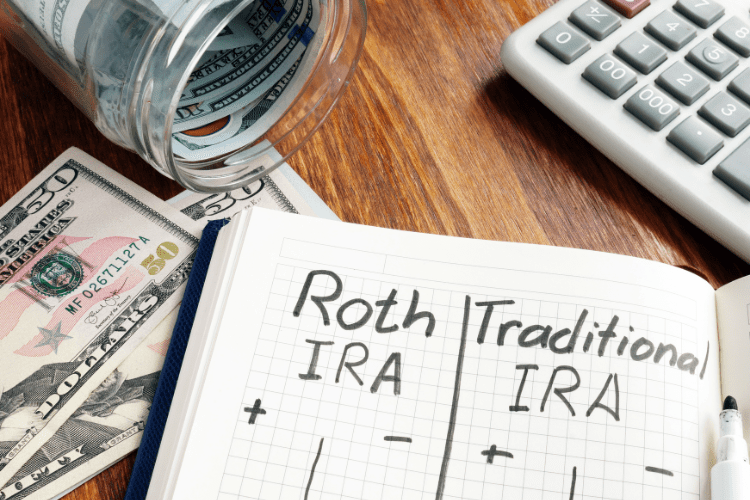The Benefits of Having Both Traditional and Roth IRA

If you’re looking for a consistent way to build a retirement fund, you can’t go wrong with a Traditional or Roth IRA. Both have major tax advantages and respectable growth year after year. By the time you retire, there’s no doubt you’ll have a comfortable nest egg waiting for you.
But if you want to advance your retirement strategy, having both accounts could make that happen even faster.
Learn more about the benefits of having two accounts at once and how to manage this strategy best!
Main Advantages Of Having Both Accounts
There’s no limit on how many retirement accounts you can have. As long as you meet the eligibility requirements, you can open a Traditional IRA and Roth IRA with no problems.
Here are a few benefits you could have by using both accounts:
Diversification
Contributing to both accounts is another way to diversify your assets and save on taxes.
Sure, a traditional IRA alone might help you avoid paying taxes for now, but you’ll still need to do it come retirement. If they go up dramatically, that initial tax-deferred growth you enjoyed initially could disappear overnight.
This is where having a Roth IRA can come in handy. Since you’re investing after-tax income, a portion of your fund will be tax-free once you start taking distributions. This move alone could end up saving you thousands.
Tax-Free Withdrawals
Traditional IRA contributions are pretax, which means you’ll need to pay them once you start withdrawing from your fund.
On the other hand, all your Roth IRA contributions are after you pay taxes. This gives you more flexibility to take contributions out whenever you need to.
Any investment distributions are also tax-free as long as:
- It’s been over five years since you started contributing
- You’re over 59 ½
- Someone withdraws funds after you pass away
- You have a permanent disability
- You’re buying, building, or rebuilding a home (maximum of $10,000)
This extra flexibility gives you more savings opportunities and lowers your tax burden.
No Minimum Distributions
The IRS forces you to take required minimum distributions (RMDs) from a traditional IRA once you hit 73. This rule prevents retirees from using their retirement accounts to avoid paying taxes.
However, Roth IRAs generally don’t have this problem since you already paid taxes on funds. This gives you more time to grow your retirement fund, especially if you’re still working and not ready to retire.
Which IRA Should You Put Most Of Your Funds In?
Deciding which plan’s right for you depends on where you see yourself financially during retirement.
Opening a Roth IRA first might be a better option if you have a low income now and anticipate it going up later. You can take advantage of the lower income tax brackets while maximizing retirement investments. Once it’s time to withdraw, you won’t need to worry about paying taxes.
Roth IRAs also don’t have RMDs, which make it especially attractive if you want to
delay retirement, grow your retirement fund more, or simply want to leave a larger nest egg to your family once you pass.
However, if you’re expecting a lower income bracket in the future, traditional IRAs should be your main focus. You’ll take advantage of saving taxes on your current income while putting some money aside into your other Roth IRA account for tax-free withdrawals later.
Eligibility Requirements For Roth & Traditional IRAs
There’s no specific age limit as to when you can open an IRA. As long as you’re making some income, anyone can contribute.
However, one thing to keep in mind is the maximum yearly account contribution, which is $7,000 for a single person under 50 and $8,000 if you’re older. So if you have both a Traditional and a Roth, the maximum contribution total across the two accounts is $7,000 or $8,000 for the year depending on your age.
Additionally, Traditional IRAs have tax-deductible income limits, while Roth IRAs have income limits on contributions:
Traditional IRAs
Single Filers
- Full tax deductions for those earning $79,000 or less
- Partial tax deductions for those earning between $79,000 and $89,000
- No deductions for those earning over $89,000
Joint Married Filers (with a work retirement plan)
- Full tax deductions for those earning $126,000 or less
- Partial tax deductions for those earning between $126,000 and $146,000
- No deduction for those over $146,000
Joint Married Filers (non-covered spouse contributing to other spouse’s workplace retirement plan)
- Full tax deductions for those earning $236,000 or less
- Partial tax deductions for those earning between $236,000 and $246,000
- No deduction for those over $246,000
Separate Married Filers (covered by workplace plan)
- Partial tax deduction for less than $10,000
- No deduction if you’re above $10,000
Roth IRAs
Single Filers
- Full contributions for those making below $150,000
- Partial contributions for those making between $150,000 and $165,000
- No contributions are allowed if you make over $165,000
Married Filers
- Full contributions for those making below $236,000
- Partial contributions for those making between $236,000 and $246,000
- No contributions are allowed if you make over $246,000
The Bottom Line
Traditional and Roth IRAs offer great benefits, so why not take advantage of both?
By opening both accounts, you can make the most out of your retirement funds. Don’t miss the opportunity to save thousands on taxes and diversify your nest egg!
Read more:









